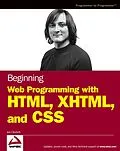What is this book about?Beginning Web Programming with HTML, XHTML, and CSSteaches you how to write Web pages using HTML, XHTML, and CSS. Itfollows standards-based principles, but also teaches readers waysaround problems they are likely to face using (X)HTML.While XHTML is the "current" standard, the book still coversHTML because many people do not yet understand that XHTML is theofficial successor to HTML, and many readers will still stick withHTML for backward compatibility and simpler/informal Web pages thatdon't require XHTML compliance.The book teaches basic principles of usability and accessibilityalong the way, to get users into the mode of developing Web pagesthat will be available to as many viewers as possible from thestart. The book also covers the most commonly usedprogramming/scripting language -- JavaScript -- andprovides readers with a roadmap of other Web technologies to learnafter mastering this book to add more functionality to theirsites.
Autorentext
Jon Duckett published his first Web site in 1996 while studying for a BSc (Hons) in Psychology at Brunel University, London. Since then he has helped create a wide variety of Web sites and has co-written more than ten programming-related books on topics from ASP to XML (via many other letters of the alphabet) covering diverse aspects of Web programming including design, architecture, and coding.
After graduation, Jon worked for Wrox Press first in its Birmingham (UK) offices for three years and then in Sydney, Australia, for another year. He is now a freelance developer and consultant based in a leafy suburb of London, working for a range of clients spread across three continents.
When not stuck in front of a computer screen, Jon enjoys listening to music and writing.
Klappentext
As the Web has evolved, tools and methods for creating Web pages have also changed and matured. This book teaches you to create Web sites using a combination of new and mature technologies and shows you the best practices that have emerged for using these technologies.
In these pages you will learn to build Web sites with traditional HTML and its successor XHTML. You will see how CSS can be used to make your Web pages more attractive by controlling the presentation and formatting of pages, and how to use JavaScript™ to enhance the power of your pages. Along the way you will learn how to make your pages work in several generations of Web browsers, including new Web-enabled devices such as mobile phones. You'll also learn techniques that make your site more usable and accessible.
What you will learn from this book
- How to create Web sites using established standards
- The differences between HTML and its successor XHTML
- How to include images and links in your pages
- Methods of collecting information from visitors to your site using forms
- Ways to control the appearance of your pages (such as fonts, colors, and backgrounds) using CSS
- How to use tables, frames, and CSS to control page layout
- Design issues such as creating simple navigation and usable forms
- How to deliver Web pages to a wide range of devices
- The basics of using JavaScript in your pages
Who this book is for
This book is for anyone who wants to understand the language of the Web and learn to create Web pages. You should know how to access and view Web pages with a browser, but previous programming experience is not necessary.
Wrox Beginning guides are crafted to make learning programming languages and technologies easier than you think, providing a structured tutorial format that will guide you through all the techniques involved.
Zusammenfassung
What is this book about?
Beginning Web Programming with HTML, XHTML, and CSS teaches you how to write Web pages using HTML, XHTML, and CSS. It follows standards-based principles, but also teaches readers ways around problems they are likely to face using (X)HTML.
While XHTML is the "current" standard, the book still covers HTML because many people do not yet understand that XHTML is the official successor to HTML, and many readers will still stick with HTML for backward compatibility and simpler/informal Web pages that don't require XHTML compliance.
The book teaches basic principles of usability and accessibility along the way, to get users into the mode of developing Web pages that will be available to as many viewers as possible from the start. The book also covers the most commonly used programming/scripting language JavaScript and provides readers with a roadmap of other Web technologies to learn after mastering this book to add more functionality to their sites.
Inhalt
Introduction.
Chapter 1: Untangling the Web.
Chapter 2: The Structure of a Page.
Chapter 3: Links and Navigation.
Chapter 4: Colors, Images, and Objects.
Chapter 5: Tables.
Chapter 6: Forms.
Chapter 7: Frames.
Chapter 8: Deprecated and Browser-Specific Markup
Chapter 9: Cascading Style Sheets.
Chapter 10: More Cascading Style Sheets.
Chapter 11: Page Layout.
Chapter 12: Design Issues.
Chapter 13: Modularized XHTML and Serving Multiple Devices.
Chapter 14: Learning JavaScript.
Chapter 15: Creating a JavaScript Library.
Summary.
Appendix A: Answers to Exercises.
Appendix B: XHTML Element Reference.
Appendix C: CSS Properties.
Appendix D: Color Names and Values.
Appendix E: Character Encodings.
Appendix F: Special Characters.
Appendix G: Language Codes.
Appendix H: MIME Media Types. Index.
